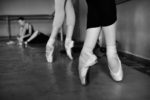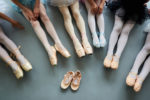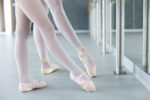Canvas vs Leather Ballet Shoes: What’s the Difference?
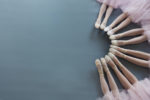
Between canvas vs leather ballet shoes, which one should you choose?
What are the best ballet shoes?
Most dancers have their specific favorite footwear.
If you are new to ballet and plans on buying your first pair, you might get confused and overwhelmed with the choices.
From the myriad of facts and myths about the best ballet shoes, let’s try to check each variety and give you a better idea about their features.
Which one should you choose between leather vs canvas ballet shoes? Let’s find out.
Canvas vs Leather Ballet Shoes
New dancers are faced with the dilemma of choosing between leather vs canvas ballet shoes.
It gets even more confusing as different resources provide varied suggestions.
Some suggest that choosing the right ballet shoes depends on different variables. Others say that dancers should pick what’s comfortable.
We all know that leather ballet shoes such as the ones from Capezio are durable; hence, they are highly recommended for beginners and young dancers.
The amount of resistance a leather ballet shoe offers can significantly help build new dancers’ strength and skill.
It is also the best ballet shoe choice for dancing on wooden floors.
However, some dance instructors don’t like the amount of time it takes for leather ballet shoes to stretch and adjust to the dancer’s foot shape.
Care and maintenance of leather ballet shoes are factors dancers need to contend with, adding to the price-point differences.
Are Leather or Canvas Ballet Shoes Better?
Ballet shoes come in canvas and leather varieties. Each one offers excellent features specific to their kind.
Regarding which is better between canvas or leather ballet shoes, most will agree that canvas is better, and here’s why:
- It fits the feet faster and better.
- Canvas will stretch to conform to the feet’s shape.
- Canvas shoes have a suede outsole for better traction.
- Cleaning is more manageable with canvas shoes.
- They are more breathable, reducing germs and fungus accumulation.
- It offers excellent sensitivity for the dancer to feel the floor better.
- They are affordable, making them easy to replace as needed.
How Long Do Canvas Ballet Shoes Last?
It’s a known fact that canvas is a weaker material than leather; hence, it needs regular replacement.
Even the best canvas ballet shoes tend to deteriorate faster than leather ones.
Once you see holes start to grow, the structural stability of the footwear weakens.
When this happens, the shoes will have a noticeable smell due to moisture and bacteria build-up.
Based on the dancers’ experience, it’s better to replace canvas ballet shoes every month.
This way, you can reduce bacteria build-up and prevent holes from growing, which will remove the support you need from the shoes.
Washing your canvas shoes may help eliminate the smell and bacteria, but it will also shrink and shorten the footwear’s lifespan.
What Type of Pointe Shoes Are Best for Beginners?
Going en pointe is an achievement for any ballet dancer.
It’s an anticipated milestone for all the training they go through in their dancing journey.
Pointe shoes have gone through numerous changes and upgrades from the time it was first invented.
Some dance instructors would offer recommendations for your first pointe shoes, sometimes citing famous brand names to choose from.
Choosing the best pointe shoes for beginners depends dramatically on your feet’ shape and the type of footwork you usually do.
No two feet are alike; thus, you cannot just go to a dance boutique and choose a specific shoe suggested by someone.
The best way to find the perfect pair is to go to a professional fitter and have your feet measured.
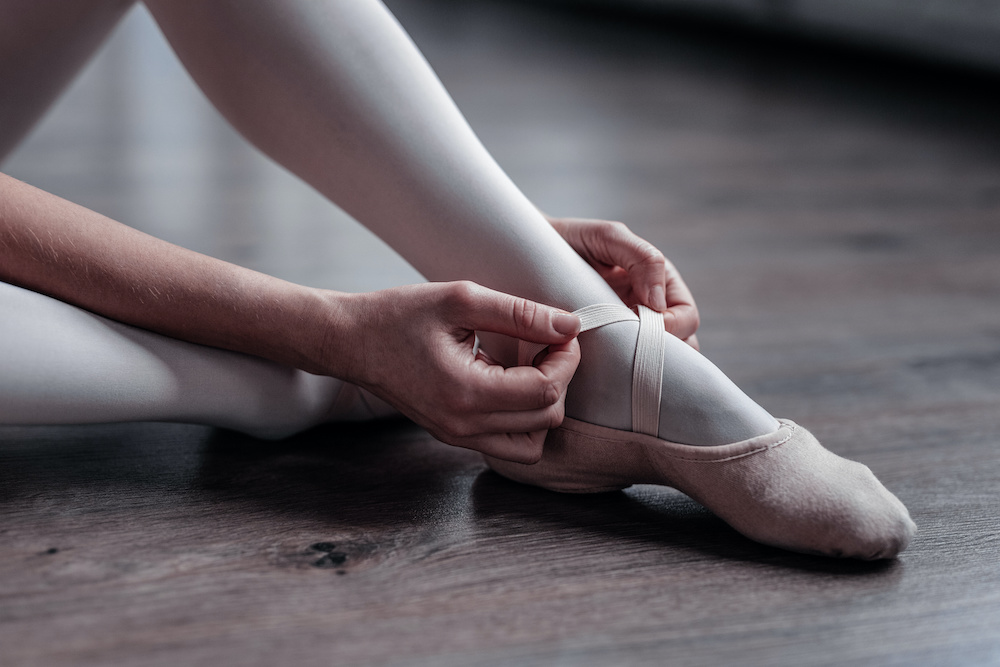
How To Choose Your First Pointe Shoes
There are plenty of options to choose from the best pointe shoes.
If it’s your first time to buy one, you must observe caution and follow specific guidelines.
1. Seek professional advice.
Ask a professional for tips and suggestions.
You can talk to your dance instructor or a professional dancer for tips.
2. Contact local dance shops.
Make an appointment with a dance shop, informing them that you are buying pointe shoes for the first time.
Confirm that they have a professional fitter.
3. Wear ballet tights on your fitting day.
Wear the usual ballet tights you use during practice when you go to your fitting schedule to ensure the right fit.
4. Pick out pads.
Pads come in different types to cushion and support your feet.
If you can’t decide which one suits you best, you can ask the fitter for assistance.
5. Try on different shoes.
After taking your measurements, the fitter may ask you to try on several shoes.
Inform the salesperson about the fit and feel so that they can make necessary adjustments.
Try standing up as you fit different shoes and look for the one that fits snugly without restricting your toe’s movement.
6. Pick your top three choices.
Narrow down your choices to three and try each one in succession.
Find the one that feels most comfortable when you are standing flat and en pointe.
7. Show your purchase to your teacher.
Have your teacher check your pointe shoes and ask for assistance in attaching the ribbon to ensure the right spot for comfort and security.
Pointe Shoe Myths
Ballerinas dancing en pointe look graceful and heavenly. As a result, all ballerinas dream of transitioning to pointe shoes.
However, some misconceptions and myths circulate among young ballerinas about dancing en pointe that may need clarifications.
1. Do ballet shoes have wood in them?
Lots of people want to know do ballet shoes have wood in them? They are stiff, but wood is not one of its materials.
Pointe shoes are handmade footwear made from layers of fabric glued together before covering it in satin and adding a stiff leather outsole.
The dried glue hardens the materials, providing enough support and stiffness to the shoes.
It may be rigid, but it’s also pliable that you can flex your foot while getting protection.
2. You transition to pointe shoes when you reach 12 years old.
Your age does not determine your readiness for pointe dancing.
Ballerinas transition to pointe shoes depending on their skill level, strength, and the teacher’s approval.
3. You can wear the same pointe shoes as your friend’s.
The brand, fit, and style of your pointe shoes are different from everyone else’s.
Each dancer requires unique specifications for their footwear.
4. Pointe work can damage your feet and toes.
Your feet and toes get all the pressure from carrying your entire body weight.
Proper care of your feet ensures it stays clean, healthy, and normal-looking.
There are available products that help ease friction and pressure on your feet and toes, but be wary of using too much as it may cause further damage.
5. Men do not do pointe work.
In the olden days, pointe work is exclusive to female dancers.
Currently, there are ballet companies composed of male members who can dance en pointe.
6. Pointe dancers can stand on their toes without wearing pointe shoes.
It’s not recommended to stand on your toes barefoot or wearing any other shoes.
Pointe shoes are made to support and enclose your feet while dancing en pointe.
7. Pointe shoes are long-lasting.
One cannot determine the lifespan of their point shoes. The shelf life differs from one ballerina to another.
Several factors determine the longevity of your pointe shoes. And wearing a damaged one cannot provide you with the right support your feet need.
8. You can wear pointe shoes straight out of the box.
Most pointe shoes don’t come with pre-sewn elastics and ribbons, which are essential to your feet’s safety and security while dancing en pointe.
Every dancer follows a routine to prepare and soften their pointe shoes before wearing them for a performance.
9. Dancing en pointe feels good, similar to how it looks.
Ballerinas en pointe look beautiful and heavenly. They make all the pointe works look easy.
In reality, it feels uncomfortable the first time.
Dancers undergo several years of training and hard work before they can perform any pointe work.
Dancing en pointe takes plenty of practice and patience.
10. You only need to wear pointe shoes to perform the skill.
Pointe shoes are not magic devices.
They are created to support the feet and ankle while dancing en pointe, but you cannot do it without proper training.
You need to have strength, skill, and core work to perform en pointe flawlessly.
What Are the Best Type of Ballet Shoes?
Choosing between canvas or leather ballet shoes may be confusing for some, especially for beginning young or adult dancers but even if you're just dressing up toddlers.
The more advanced dancers know what they prefer.
Canvas ballet shoes conform to your feet faster and require shorter break-in periods. Some even wear it straight out of the box.
They are also affordable and easy to clean and maintain.
However, you need to replace the shoes at least every 30 days to prevent bacteria accumulation.
Leather ballet shoes are more durable but may need some time to break-in and conform to your feet’s shape.
They are also more expensive and harder to maintain.
When choosing between canvas vs leather ballet shoes, pick the one that feels comfortable and supportive to your feet.
It would also help to look at ballet shoe reviews.


